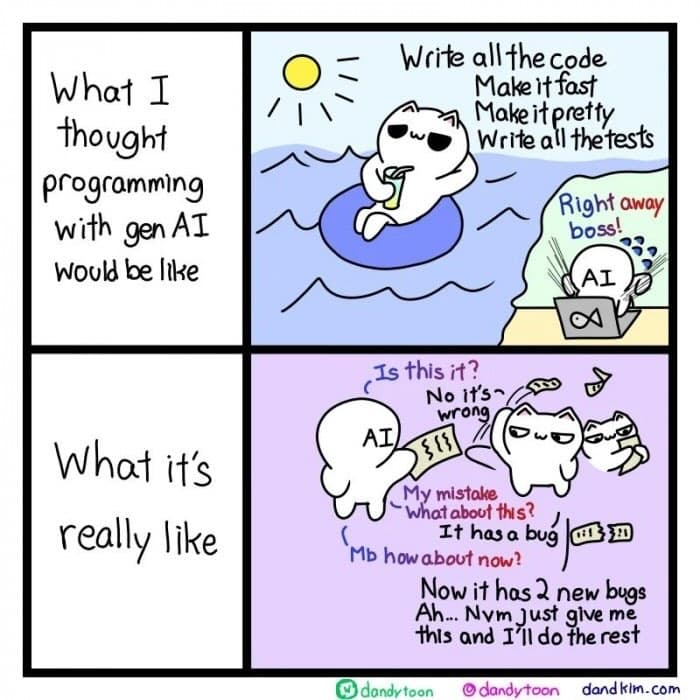One Year of AI-Assisted Development
Reflections on how my workflow has evolved since my initial post about AI-assisted development
Introduction
It’s been just over a year since I wrote about getting the hang of AI-assisted development. What started as an exciting new workflow has now become an integral part of how I build software. The pace of change in tools and techniques has been relentless—and the way I interact with these systems has changed just as much. This post is about that shift. It’s not just about better autocomplete—it’s about how I’ve gradually reoriented my role, how I work, and how I think about writing software.
The Evolution of My Toolkit
The core stack—Cursor, Copilot, GPT-4—hasn’t changed. What’s changed is how I use them. Early on, I leaned on AI like a stronger autocomplete. Now, it’s more like a remote pair programmer who owns the keyboard and does the heavy lifting. I’ve shifted from writing code to describing outcomes.
There’s been no shortage of new entrants—Replit’s Ghostwriter, Claude, Devin, Cody, even plugins baked into JetBrains and VS Code. I’ve tried most of them. Some are sharp, others are hype. The ones that stick? The ones that integrate directly with my editing loop and take feedback well. GPT-4 is still at the center of it all, increasingly so with voice.
Beyond Code Generation: New Workflow Patterns
The biggest shift for me has been how I communicate. I now treat the assistant like a teammate—one I trust to get things done. I don’t over-explain. I describe the intent, the constraint, and the goal. Then I see what comes back.
I’ve found myself speaking to the AI more and more like a collaborator. I want the system to attempt something real, so I can respond to that rather than iterate from scratch.
This past year, I also leaned hard into voice. It’s hard to overstate how much that’s changed the game for me. Recording voice notes feels more fluid, more natural, and much faster than typing out carefully constructed prompts. I’ll pace around the room or glance through a design doc while explaining what I want built. There’s an immediacy and nuance that typing just doesn’t give me.
Measuring the Impact
From a productivity standpoint, I’ve shipped more, faster. But more importantly, the ceiling of what I can build solo has lifted. I can orchestrate bigger projects without getting bogged down in implementation.
Quality is up. Not because AI writes perfect code—it doesn’t. But because I spend more time reviewing, testing, and improving. It’s changed how I allocate time. I spend less energy doing and more energy thinking.
The learning curve has flattened too. I find myself jumping into unfamiliar frameworks or APIs without dread. AI helps me get oriented quickly. I still need to make the call, but I get there faster.
Challenges and Limitations
The biggest challenge I’ve run into isn’t hallucination or context drift—it’s abstraction. The more I let the assistant handle details, the more I risk losing track of the architecture. If I’m not careful, I become a manager of prompts, not a builder of systems.
When that abstraction breaks down—when a bug creeps in or something unexpected happens—I suddenly need to reload a mental model I never fully constructed. It’s like jumping into a half-written novel and trying to guess the plot. You spend real time reconstructing what happened, where things live, and why they were done that way.
This kind of “vibe coding” works, until it doesn’t. And when it doesn’t, the cost of reentry is steep. That’s pushed me to stay closer to the structure—not necessarily writing every line, but reviewing with more intent, asking more from the assistant about its decisions, and taking snapshots of key logic as breadcrumbs for later.
The Future of AI-Assisted Development
We’re past autocomplete. We’re past “it helped me write that regex.” We’re now in the early innings of AI-native workflows. The assistant isn’t a shortcut—it’s a collaborator.
I expect more voice. More context memory. More local integration. I’d bet on tighter loop tools, where AI is not just helping write code, but helping prioritize, test, review, refactor, and eventually own pieces of the system.
For developers getting started today: don’t treat it like a static tool. Treat it like a peer you’re pairing with. Communicate with clarity, provide feedback, and stay engaged in the outcome. The sharper your direction, the stronger the result.
Conclusion
AI hasn’t made me faster in the way a faster compiler or better IDE might. It’s made me faster in the way working with a competent colleague does—by pushing me to clarify, delegate, and stay out of the weeds.
It’s also shifted the energy of coding. When things are flowing, it feels less like keystrokes and more like dialogue. Sometimes clumsy, sometimes sharp, occasionally uncanny—but it’s no longer just tooling. It’s collaboration.
My setup today is simple: Cursor, GPT-4, a set of evolving instructions, and my own voice. That last piece—voice—has been the real unlock. It’s how I think out loud. It’s how I shape intent into direction. And increasingly, it’s how I code.
One year in, I don’t see AI as replacing developers. But I do think it’s replacing the old mental model of what writing software looks like. And if I’ve learned anything this year, it’s this: the better I get at expressing what I want, the better the machine gets at building it.
The interface is conversation. The leverage is clarity. And that feels like a shift worth committing to.


